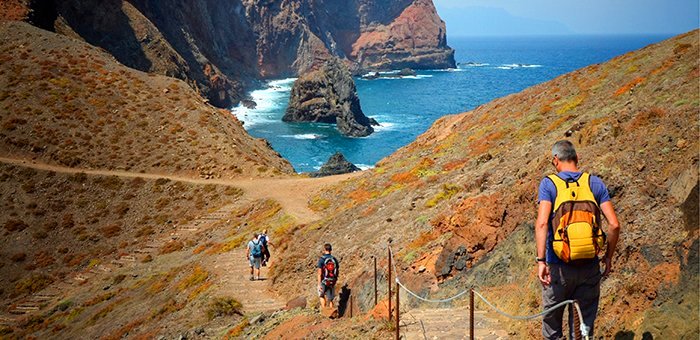 7.2 km – Round trip – Moderate
7.2 km – Round trip – Moderate  2-3h
2-3h  4.6
4.6
Book this Vereda. Check here
Visiting some of the finest cliff scenery on Madeira, this walk explores the long thin peninsula at the eastern end of the island. The paths are good, but undulating – whether you get close to the edges is up to you.
The trail follows S. Lourenço Point, the eastern-most peninsula of Madeira island, named after the caravel sailed by João Gonçalves de Zarco, one of the three discoverers of Madeira island, who on coming near this piece of land shouted to his ship “São Lourenço, that’s enough!”.
This peninsula is volcanic in origin, and is mainly made of basalt, although there are also some limestone sediment formations. At the end of the Point there are two islets: the Cevada, Metade or Desembarcadouro Islet, and the S. Lourenço Point, Farol or Fora Islet. The stone partition marks where the Regional government’s land begins, and is part of the Madeira Natural Park. The peninsula is classified as a partial natural reserve and the Desembarcadouro Islet is a total natural reserve. All the land and sea by the North coast, up to a depth of 50m, is part of the European network of important community sites – Natura 2000.

The semi-arid climate and its exposure to North winds have sculpted the low vegetation and explain the lack of trees, which distinguish this area from the rest of the Island and is a veritable natural heritage. Here you can see the Island’s basal plate at its best and several rare and endemic plants. Of the 138 species of plant identified on the peninsula, 31 are endemic (exclusive) to Madeira island. In terms of fauna there is one of the largest colonies of seagull (Larus cachinnans atlantis) in the region, which nests on the Desembarcadouro islet.
Along the route you can often see several bird species such as the Berthelot’s Pipit (Anthus bertheloti madeirensis), the Goldfinch (Carduelis carduelis parva), the Common Canary (Serinus canaria canaria), and the Kestrel (Falco tinunculus). Protected marine birds also nest here such as Cory’s Shearwater (Calonectris diomedea), the Band-rumped Storm-Petrel (Oceanodroma castro), Bulwer’s Petrel, (Bulweria bulwerii), and the Common Tern (Sterna hirundo). The Madeiran lizard (Lacerta dugesii), which is the island’s only reptile, is very common here. Another interesting aspect of this area is the high number of endemic land molluscs (24), commonly known as snails.

In the sea, you may be lucky enough to spot the world’s rarest seal, known in Madeira as a Sea-wolf (Monachus monachus).
At the end of the trail, you can dive in the Sardinha port, named after the old owners.
The Sardinha house is the base for a group of Rangers who work for the Madeira natural park, and who are responsible for watching over the area.
On the horizon to the South you can see Ilhas Desertas (Deserted Islands) and to the North the Porto Santo Islands.
Book this Vereda. Check here

Comment (0)